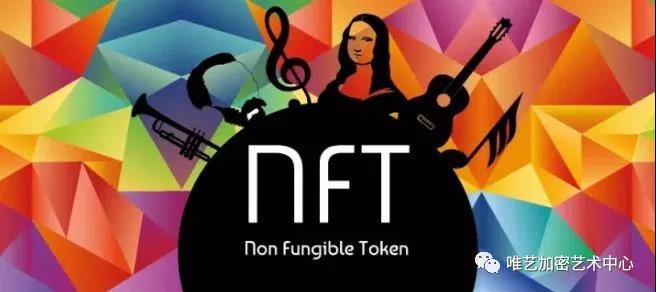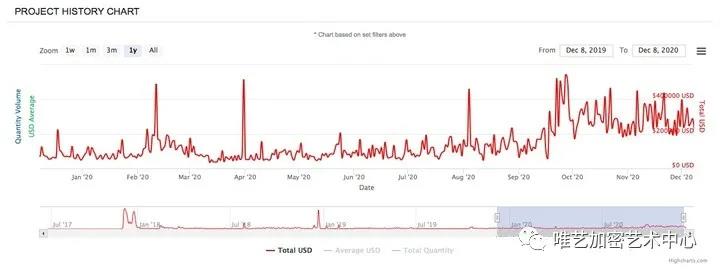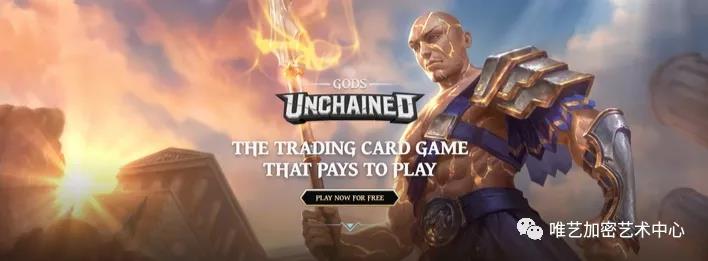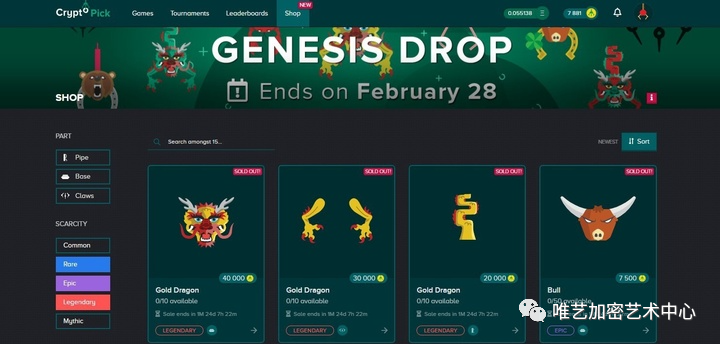
What are NFTs?
What are NFTs?
What would happen if your physical collection could be expanded into a digital virtual world?
In the past few months, NFT has been discussed globally, and it is believed that NFT will occupy a place in the crypto world in 2021. The history of the encryption world is short, but it has set off several waves: IC0 in 2017, smart contract platform in 2018, stable currency in 2019, and DeFi in 2020.

DeFi has been the shining star for most of 2020, but in recent months, the popularity of NFT has also risen steadily. Ilya Abugov, project manager of DappRadar, said: "There is indeed a lot of hype about NFT, and from a certain perspective, it is an extension of people's interest in DeFi.
NFTs are tokenized versions of non-fungible assets such as artwork, real estate, or collectibles. Non-fungible assets have unique properties and personal characteristics that make them unique and valuable.
Since the inception of cryptocurrencies, the crypto world has been dominated by fungible tokens for the past decade. "Homogeneity" is a more complicated concept, but it is not difficult to understand.
Simply put, it refers to the fungibility of assets. If two items can be interchanged at will and their owners will not dispute this, then the two items are "homogeneous".
For example, if two people exchange a one-dollar bill with each other, the two bills are indistinguishable in themselves and in the value they represent, then they are said to be "homogeneous". Only if either party cares about the serial number of the note and where it was created, do the two notes become non-fungible.
From another perspective, NFT can represent anything unique in the world.
NFTs can be used to represent various assets such as virtual collectibles, in-game assets, virtual assets, digital artwork, real estate, and more. However, since each token is unique, they cannot be traded as easily as fungible tokens. For example, you wouldn't choose to trade in a rare, old, valuable vintage car for a regular car.
Another reason NFTs differ from fungible tokens is that NFTs are indivisible: you can’t trade fractions of them the way you can with Bitcoin. For example, you can't cut out a small part of a concert ticket and send it to a friend, and none of you will be able to get through the ticket gate using only a small part of the ticket.
Why are NFTs getting so much attention now?
In fact, NFT is not a new concept. The first NFT-like token, Bitcoin 2.X (also known as colored coins), was born in 2012.
In terms of market value, the market value of the NFT industry increased by 17% in 2019 and by 50% by the end of 2020. The massive increase in market capitalization is intriguing because it says that in less than two years, NFTs have created more than $200 million in total value from scratch.

According to the NFT data analysis website (http://NonFungible.com), since September 2020, the number of NFT sales has increased significantly and has remained higher than the level in the first few months of 2020. In the first week of September 2020, NFT sales approached $1 million, with sales of the blockchain-based fantasy football card game Sorare reaching over $211,000. And the momentum shows no signs of slowing down, with $2 million worth of NFTs being traded in the first week of December 2020. According to CoinGecko, the market capitalization of NFTs has surpassed its 2020 forecast to reach more than $550 million.
Although the development speed of NFT has slowed down after experiencing the initial boom in 2017, there are still new developments in the NFT field. Especially in recent months, some events and projects have attracted a lot of attention, and the sales of NFT projects have reached record levels.

It is worth noting that more and more celebrities have also begun to enter the NFT field. Paris Hilton auctioned off pictures of her pet cat Munchkin at a price of 40ETH (valued at $17,000 at the time) to raise funds for charity.
With the recent hustle and bustle of NFT, major companies and brands have become interested in and participated in this industry. Currently, some world-renowned brands are developing blockchain-based games, collectibles, and virtual worlds. These include the National Basketball Association (NBA), National Football League (NFL), Ultimate Fighting Championship (UFC), Formula One, Louis Vuitton, Samsung and Nike, to name a few. The participation of these big brands is an important development in the mainstreaming of NFT, as new users can understand the concept of NFT through channels they are passionate about and already familiar with.
The characteristics of NFT: their charm
The three desirable characteristics of NFTs are: provable authenticity, providing ownership and transferability.
1. Authenticity
Piracy is a huge problem in many industries, especially in the fine art and luxury goods sectors. Cointelegraph wrote in a previous article: "Blockchain technology powers NFT, which can crack down on piracy so that buyers don't have to worry about buying fakes." And luxury brand group LVMH, the owner of the Louis Vuitton brand, also are riding the NFT wave and getting ready to launch a blockchain to prove the authenticity of their luxury items. Louis Vuitton plans to make each product into an NFT, so that authenticity can be verified. In addition, users can also track the complete life cycle of a product from the crocodile farm to the store, and then view every previous buyer and sellers.
2. Ownership
Blockchain technology enables people to truly start owning things that are their own. It is worth noting here that due to its smart contract and related rights, NFT can only be traded and transferred by the owner of the asset. This means that even the issuer of an NFT cannot copy or transfer an NFT without the permission of its owner.
3. Transferability
Since NFTs are decentralized, there is no need for a central issuer and their transfer will be easier. It allows users to go deep into peer-to-peer interaction, transactions and professional markets without permission, without the intervention of third parties, the whole process will become quick and easy.
Why are NFTs so exciting?

NFT is creating opportunities for all kinds of content creators (visual art, game designers, musicians, etc.) and allowing them to obtain new income. Part of what makes them so exciting is that they can represent all kinds of assets: virtual collectibles, game items, digital artwork, event tickets, real estate, IDs, certificates, and more. WAX co-founder William E. Quigley boldly stated: "NFT will go hand in hand with movies, music, and video games as a unique form of entertainment. Every non-food consumer product will become an NFT.
Due to the ease of transfer and proof of ownership, NFTs undoubtedly offer a wide range of possibilities for both real-world and virtual assets.
The current crypto market mainly revolves around bitcoin and cryptocurrency trading and mining. But in order to encourage their mass adoption, it needs to move away from these areas.